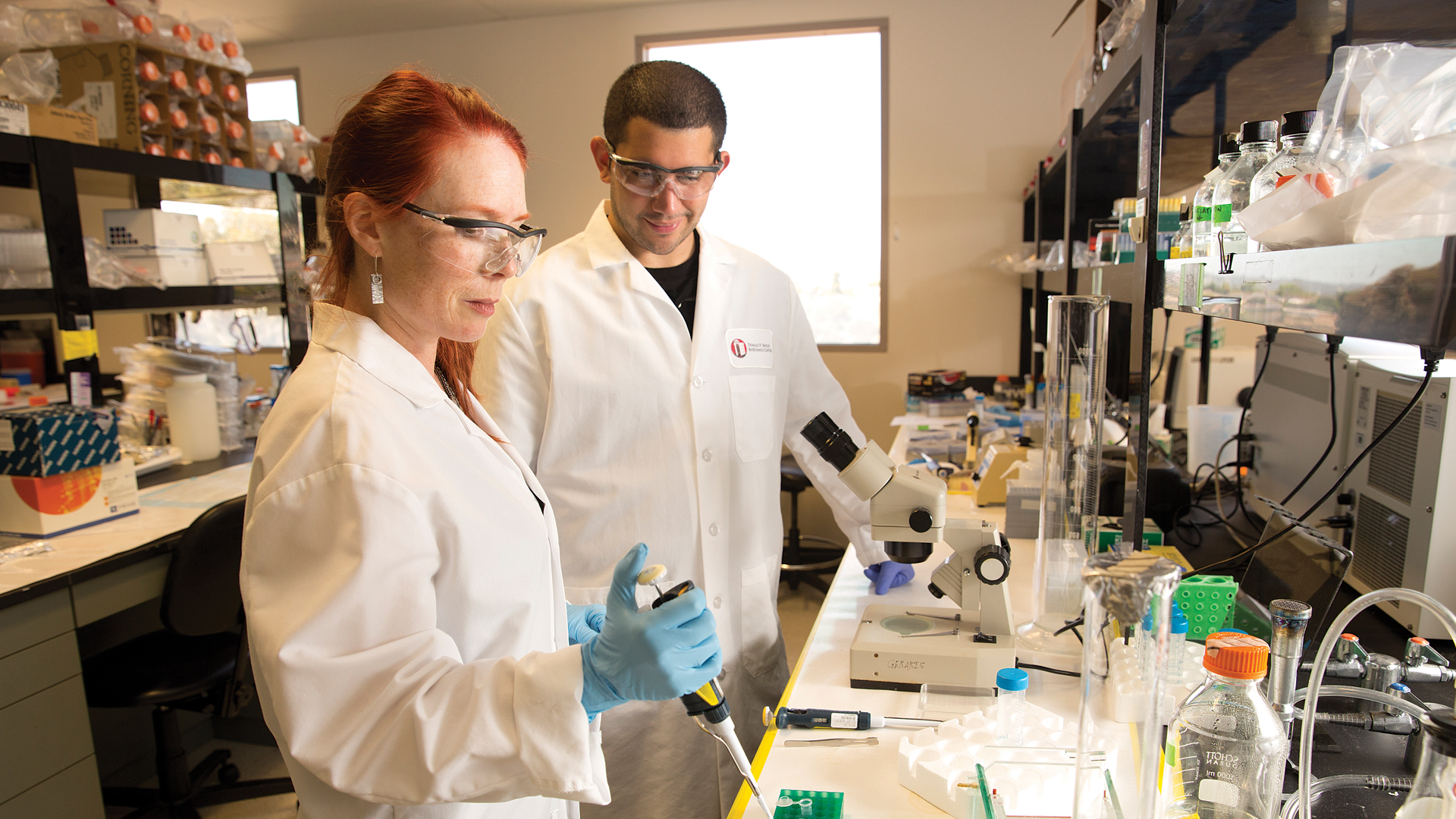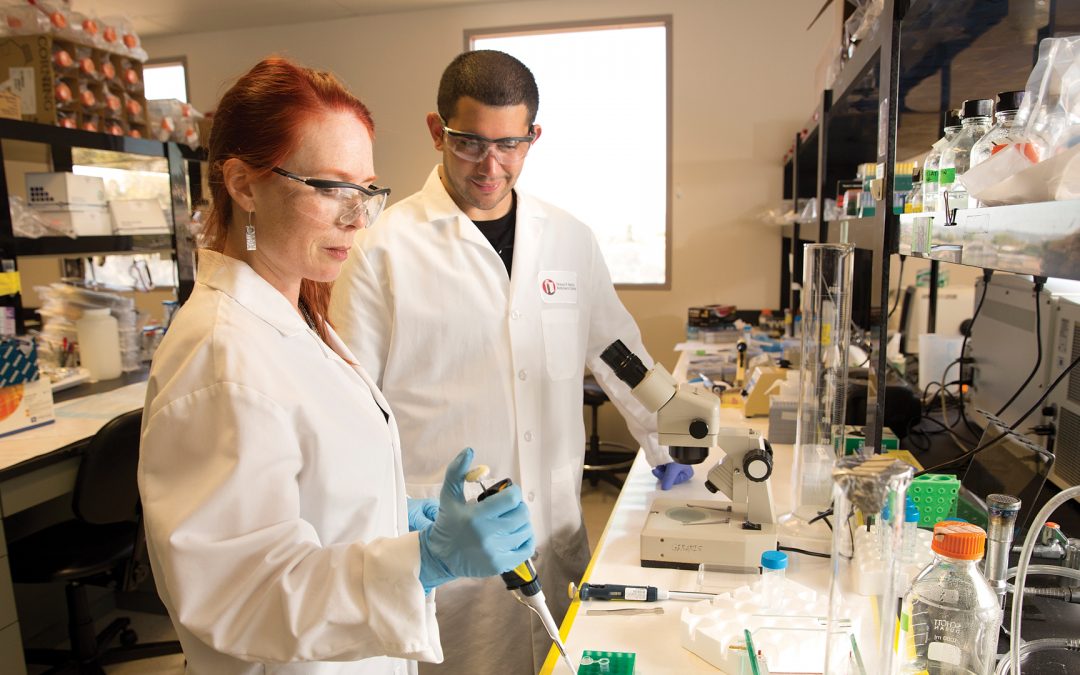
Before The Campaign for SDSU launched in 2007, research activity at San Diego State University was already strong. “It’s important that people understand the campaign was building upon an already solid foundation,” said Stanley Maloy, dean of the College of Sciences. “We were strong at research then, but the campaign has allowed us to grow stronger.”
Spring 2017 issue of 360: The Magazine of San Diego State University
Fall 2017 Cover of 360: The Magazine of San Diego State UniversityOver the past 10 years, The Campaign for SDSU has grown that seed of expertise into several robust, nationally recognized research platforms. Endowed chair positions and internal funding have allowed faculty to broaden the scope and the impact of their research programs. Scholarships and stipends have allowed more students to participate in hands-on research experiences that help them succeed in graduate school and later in their careers. New state-of-the-art buildings are literally laying the groundwork for the next generation of scientists and engineers intent on solving society’s most pressing problems.
The net effect is that SDSU’s strength in research is now much more widely known and appreciated, making the university a desirable destination for superstar faculty and graduate students and setting it up for continued success.
“The quality of a research university is a function of the quality of its faculty and of its students,” said Stephen Welter, SDSU’s vice president for research and dean of graduate affairs. “The philanthropic investments made throughout the campaign have set a platform that can attract the best and brightest faculty and grad students.”
In total, some $15 million has been raised for research endowments, including endowed chair positions, scholarships and funds—all dedicated to supporting and growing the university’s research infrastructure.
Heart start
The first sign that the campaign would energize and raise up SDSU’s research enterprise—and one of the most significant early gifts in the campaign—was San Diego philanthropist Darlene Shiley’s $5 million gift in 2011 that named the Donald P. Shiley BioScience Center for her late husband, who invented the Bjork-Shiley heart valve. The top-of-the-line bioscience facility became the first center in the nation to focus on the links between infection, inflammation and heart disease.
“Darlene Shiley’s gift was a very critical early contribution that allowed us to expand into types of research that we hadn’t been able to do before,” Maloy said.
In that same vein, another big impact of the campaign on research will be the Engineering and Interdisciplinary Sciences (EIS) Complex, scheduled for completion early next year. The 85,000-square-foot complex will replace the campus’s Industrial Technology building with a state-of-the-art facility dedicated to sparking collaborative research. Shared workspaces, mobile equipment and the intentional grouping of scientists and engineers from a wide range of disciplines will inspire new ways of thinking and new solutions for intractable problems like climate change and devastating diseases.
A cutting-edge magnetic resonance imaging machine in the EIS Complex will anchor the university’s first brain imaging center, lending new research opportunities to students and faculty working to understand the brain’s biological underpinnings, as well as making them more competitive for research funding. Entrepreneurship will also play a central role in the EIS Complex. A gift to the campaign from the Moxie Foundation created the Zahn Innovation Platform (ZIP), which is home to a tech incubator, a Design Thinking lab, and a brainstorming lounge. Another gift created the Lavin Entrepreneurship Center to support academic scholarship and curricula centered on empowering students to launch their own businesses. Both of these centers will be housed in the EIS Complex inside the William E. Leonhard Entrepreneurship Center, itself the result of yet another gift to the campaign.
“By getting their fingernails dirty as they transform their ideas and research into real-world applications, students gain skills and experiences that last a lifetime,” said Peter Zahn, Moxie Foundation president.
Another prominent research presence within the complex will be the Viral Information Institute. A $2.5 million gift from the late philanthropist Conrad Prebys endowed the Conrad Prebys Chair in Biomedical Research to spearhead a cross-disciplinary approach to learning about bacteriophages and exploring their medical potential.
Bright future
Looking to the future, Welter said The Campaign for SDSU has paved the way for the university’s research strength to continue to grow and deepen for many years to come. Across a variety of fields and disciplines, SDSU has hired more than 300 new faculty members in the last four years, bringing in new blood and new ideas. For many of them, the decision to join SDSU hinged on the realization that the university, bolstered by philanthropy, is committed to their success.

